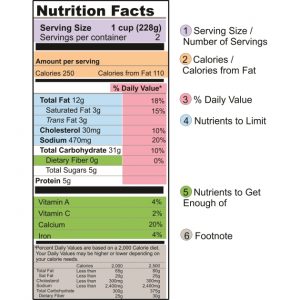 Consumer interest in food labeling is growing. Unfortunately a big barrier to reading food labels is that they are difficult to understand. Shoppers need to have the skills to decode the complicated jargon.
Consumer interest in food labeling is growing. Unfortunately a big barrier to reading food labels is that they are difficult to understand. Shoppers need to have the skills to decode the complicated jargon.
Did you know?
- It is illegal to make false or misleading claims on food labels
- Food companies do not have to provide nutritional information unless a health claim, such as ‘low in fat’, is made.
- Ingredients are listed in descending order i.e. largest ingredient first
- All nutritional information must be given per 100g or per 100ml
- The terms ‘light’ and ‘lite’ don’t mean anything in relation to food and can be used by anyone on any product.
- Sodium is not the same as salt. Salt is sodium chloride so sodium is just one part of a molecule of salt.
Here’s how you figure out salt from sodium: Sodium x 2.5 = Salt content. Salt / 2.5 = Sodium content
Sodium is the main ingredient of salt. This number is important for people who are trying to get less salt in their diet. If a label says that a food has 100 mg of sodium, this means it has about 250 mg of salt. You should eat no more than 2,300 mg of sodium per day
The Nutrition Panel
This is where you will find the information on the nutrient breakdown of a product. It is not obligatory unless a company makes a health claim.
Energy is measured in kilocalories (kcals) and kilojoules (kJ). Other nutrients are shown in grams (g).
Sometimes manufacturers provide more information on their labels than others. Where a nutrient is particularly abundant in a food, like vitamin C in orange juice, the manufacturer may want to draw attention to the product.
To use a caption like ‘High in Vitamin C’, the quantity of vitamin C must be detailed on the nutrition panel as proof. Health authorities have approved the following health claims.
To use one of these claims, manufacturing companies must comply with set criteria.
- Low Fat / 95 % Fat Free = Less than 5g fat in 100g
- Low in Saturates = Less than 3g saturated fat in 100g
- Virtually Fat Free = Less than 0.3g fat in 100g
- Reduced Fat = At least 25% less fat than standard product
- Low Sugar = Less than 5g sugar in 100g
- Sugar Free = No added or naturally occurring sugar
- No Added Sugar = No extra sugar added
- Reduced Sugar = At least 25% less sugar than standard product
- High Fibre = At least 6g fibre in 100g
- Reduced Sodium (salt) = At least 25% less sodium (salt) than standard product
- Low Calorie / Diet = Less than 40 calories in 100g or 100ml
What about ‘Use By’ dates?
You should not eat foods after their ‘Use By’ date as they might not be safe to eat. Microbial changes take place in the food after this time that can put your life at risk. ‘Best Before’ dates are slightly different. This is more to do with quality than safety. It means that the product is best eaten before this date. The flavour or texture may deteriorate after this date but it is not unsafe, with the exception of eggs.
Pictures on food packaging
The pictures on packets and labels must not be misleading. A strawberry yoghurt that gets its flavour from artificial flavouring, and not from fruit, is not allowed to have a picture of strawberries on the pot.
Carbohydrates
The label will say; Carbohydrates and then ‘of which sugars’. So it will tell you the total carbs and then how much of this is sugar. The one to pay particular attention to is sugar.
Sugar
Men should try to have less than 35g of sugar per day (7 teaspoons)
women should try to have less than 25g of sugar per day (5 teaspoons)
Fibre
Dietary fibre is listed just below total carbs. Buy foods with at least 3 to 4 grams of fiber per serving
Whole-grain breads, fruits and vegetables, and beans and legumes are high in fiber.
Men should try to have at least 35g of fibre per day
Women should try to have at least 25g of fibre per day
Protein
Aim for one gramme of protein per pound of your body weight. So, if you weigh 150lbs, try to get in 150g of protein per day.
Fat
Saturated fat is not the enemy we once thought it was and it is fine in natural foods such as butter, meats and fish. Men can have 30g of saturated fat per day and women can have 20g.
Fats may be broken down into saturated and unsaturated – choose products with a majority of unsaturated rather than saturated fat.
Trans Fats
Avoid trans fats. You should also pay attention to trans fats on any food label. These fats raise “bad” cholesterol and lower your “good” cholesterol.
These fats are mostly found in snack foods and desserts. Many fast food restaurants use trans fats for frying.
If a food has these fats, the amount will be listed on the label under total fat. They are measured in grams. Look for foods that have no trans fats or are low in them (1 gram or less).
The percentage for each item on the label is based on eating 2,000 calories a day. Your goals will be different if you eat more or fewer calories a day.
Please make contact with us here at lifegym if you would like us to work out your personal Calorie profile, as in, how many Calories you should be consuming and how much from each of the Macro Nutrient groups (Fat / Protein / Carbs)




